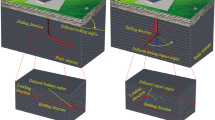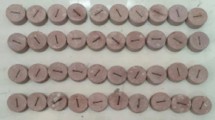Abstract
Based on the cracked chevron notched Brazilian disc method, the I-type fracture toughness of Longmaxi Formation shale is measured and the influence of different factors on the fracture toughness of the shales are also discussed. The results show that the fracture toughness of the cores drilled parallel to the bedding ranges from 0.4744 to 0.8752 MPa m0.5 and that of the cores drilled perpendicular to the bedding ranges from 0.4259 to 0.6159 MPa m0.5, which means that the fracture toughness of shale is significantly anisotropy. The clay minerals in the shales have a positive effect on shale fracture toughness while the brittle minerals in shale play a negative role on shale fracture toughness. Being through high temperature processes, the microstructures of the shales are damaged, resulting in lower fracture toughness. Due to the hydration of shales, the interaction between the shale and the water leads to the decrease in the fracture toughness. The increase in the immersion pressure also cause the fracture toughness to decrease.








Similar content being viewed by others
References
Chen S, Zhu Y, Wang H, Liu H, Wei W, Fang J (2011) Shale gas reservoir characterization: a typical case in the southern Sichuan Basin of China. Energy 36:6609–6616
Chen J, Deng J, Yuan J, Yan W, Wei B, Tan Q (2015) Study on fracture toughness evaluation methods of shale reservoir type I and II. Chin J Rock Mech Eng 35(6):1101–1105
Cui Z, Liu D, An G, Zhou M, Li Z (2010) Experimental study on determination of fracture toughness KIC of rock by v-cut Brazilian disc method. Rock Soil Mech 31(9):2743–2748
Fan H, Zhang S, Gou X, Wang Q (2011) A new numerical calibration of the critical stress intensity factor of rock fracture toughness test specimen by CCNBD. Chin J Appl Mech 28(4):416–422
Fischer M, Elsworth D, Alley R, Engelder T (1996) Finite element analysis of the modified ring test for determining mode I fracture toughness. Int J Rock Mech Min Sci Geomech Abstr 33(1):1–15
Guo H, Aziz N, Schmidt L (1993) Rock fracture-toughness determination by the Brazilian test. Eng Geol 33(3):177–188
ISRM Testing Commission (1988) Suggested methods for determining the fracture toughness of rock. Int J Rock Mech Min Geomech Abstr 25(2):71–96
ISRM Testing Commission (1995) Suggested method for determining mode I fracture toughness using cracked chevron notched Brazilian disc (CCNBD) specimens. Int J Rock Mech Min Sci Geomech Abstr 32:57–64
Kahraman S, Altindag R (2004) A brittleness index to estimate fracture toughness. Int J Rock Mech Min Sci 41(2):343–348
Li C (2013) Effect of temperature on fracture properties of rock materials. J Nanjing Inst Technol (Nat Sci Ed) 11(4):39–46
Li G, Sheng M, Tian S, Ge H, Huang Z, Song X (2016) Discussion on basic problems of horizontal wells and fracturing engineering of shale gas reservoir. Chin Sci Bull 61(26):2883–2890
Liang L, He S, Zhang A (2015a) The tests shale type I fracture toughness of CCNBD samples. West-China Explor Eng 35(6):1101–1105
Liang L, Xiong J, Liu X (2015b) Experimental study on crack propagation in shale formations considering hydration and wettability. J Nat Gas Sci Eng 23:492–499
Liang L, Xiong J, Liu X (2015c) Mineralogical, microstructural and physiochemical characteristics of organic-rich shales in the Sichuan Basin, China. J Nat Gas Sci Eng 26:1200–1212
Liang L, Zhuang D, Liu X, Xiong J (2017) Study on mechanical properties and failure modes of Longmaxi shale. Chin J Undergr Space Eng 13(1):108–116
Liu X, Xiong J, Liang L, Luo C, Zhang A (2014) Analysis and influence discussion of shale wettability in Longmaxi Formation in south Sichuan area. Nat Gas Geosci 25(10):1644–1652
Liu X, Xiong J, Liang L, Ding Y (2017) Investigation of the physico-chemical and mechanical properties of hard brittle shales from the Shahejie Formation in the Nanpu Sag, northern China. J Geophys Eng 14(3):445
Lyu Q, Long X, Ranjith PG, Tan J, Kang Y, Wang Z (2018a) Experimental investigation on the mechanical properties of a low-clay shale with different adsorption times in sub-/super-critical CO2. Energy 147:1288–1298
Lyu Q, Long X, Ranjith PG, Tan J, Kang Y (2018b) Experimental investigation on the mechanical behaviours of a low-clay shale under water-based fluids. Eng Geol 233:124–138
Ren W, Tian S, Li G, Sheng M, Yang R (2017) Modeling of mixed-gas adsorption on shale using hPC-SAFT-MPTA. Fuel 210:535–544
Tang T, Bažant Z, Yang S, Dan Z (1996) Variable-notch one-size test method for fracture energy and process zone length. Eng Fract Mech 55(3):383–404
U.S. Energy Information Administration (EIA) (2013) Technically recoverable shale oil and shale gas resources: an assessment of 137 shale formations in 41 countries outside the United States. http://www.eia.gov/analysis/studies/worldshalegas
Wang Q, Xing L (1999) Determination of fracture toughness KIC by using the flattened Brazilian disk specimen for rocks. Eng Fract Mech 64(2):193–201
Wang Y, Dong D, Li J, Wang S, Li J, Wang L, Cheng K, Huang J (2012) Features of shale gas reservoir in Longmaxi Formation of lower Silurian in south Sichuan. Acta Petrol Sin 33(4):551–561
Wang T, Tian S, Li G, Sheng M, Ren W, Liu Q, Zhang S (2018) Molecular simulation of CO2/CH4 competitive adsorption on shale kerogen for CO2 sequestration and enhanced gas recovery. J Phys Chem C 122(30):17009–17018
Wei X, Liu R, Zhang T, Liang X (2013) Micropore structure characteristics and development control factors of shale gas reservoir—a case study of Longmaxi Formation from south Sichuan to north Guizhou. Nat Gas Geosci 24(5):1048–1059
Xiong J, Liu X, Liang L (2015) Experimental study on the pore structure characteristics of the Upper Ordovician Wufeng Formation shale in the southwest portion of the Sichuan Basin, China. J Nat Gas Sci Eng 22:530–539
Yan C, Deng J, Wei B, Tan Q, Deng F, Zhu H, Hu L, Chen Z (2013) Study on collapse pressure of shale gas reservoir. Chin J Rock Mech Eng 32(8):1595–1602
Yan J, Fan J, Wang M, Li Z, Hu Q, Chao J (2018) Rock fabric and pore structure of the Shahejie sandy conglomerates from the Dongying depression in the Bohai Bay Basin, East China. Mar Pet Geol 97:624–638
Yang S, Tang T, Zollinger DG et al (1997) Splitting tension tests to determine concrete fracture parameters by peak-load method. Adv Cem Based Mater 5(1):18–28
You L, Kang Y, Chen Q, Fang C, Yang P (2017) The prospect of increasing shale gas recovery rate by oxidative explosion. Nat Gas Ind 37(5):53–61
Yu J, Shang X, Wu P (2016) Theoretical analysis and experimental study of shale disc fracturing. Sci Sin Technol 46(2):135–141
Acknowledgements
This research is supported by the National Science and Technology Major Project (Grant No. 2016A-3301), the National Natural Science Foundation of China (Grant No. 41772151).
Author information
Authors and Affiliations
Corresponding author
Ethics declarations
Conflict of interest
The authors declare that there is no conflict of interests regarding the publication of this paper.
Additional information
Publisher's Note
Springer Nature remains neutral with regard to jurisdictional claims in published maps and institutional affiliations.
Rights and permissions
About this article
Cite this article
Xiong, J., Liu, K., Liang, L. et al. Investigation of Influence Factors of the Fracture Toughness of Shale: A Case Study of the Longmaxi Formation Shale in Sichuan Basin, China. Geotech Geol Eng 37, 2927–2934 (2019). https://doi.org/10.1007/s10706-019-00809-0
Received:
Accepted:
Published:
Issue Date:
DOI: https://doi.org/10.1007/s10706-019-00809-0




